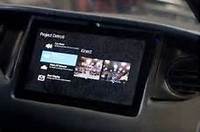Can Telematics Help Automotive Manufacturers Upsell?
 |
Long-term subscriptions for connected services improve customer retention
MOUNTAIN VIEW, CA--July 31, 2013: In its second coming, telematics appears to have greater appeal for vehicle original equipment manufacturers (OEMs), especially in North America. Market participants' rose-tinted view of the future might not be entirely unfounded, going by the success of the Hyundai Bluelink, BMW Assist, GM OnStar and several other connected services in vehicles.
"Vehicle manufacturers are waking up to the advantages of signing up users for a connected service for three or more years than having them pay a monthly subscription of $15 or $20 for a year," said Frost & Sullivan Telematics and Infotainment Research Manager Praveen Chandrasekar. "Manufacturers are increasingly offering these services as a standard feature in their models and are tying their costs into the overall vehicle costs to lower upfront costs."
Of all OEMs, the most aggressive in this area is Hyundai with its Bluelink program, followed closely by GM with OnStar and its planned long-term evolution (LTE) solution.
GM has been bold enough to make OnStar a standard feature in almost all its models, resulting in a service, that even with just 40 percent retention rate, has added almost 35 percent net revenue to its margins year on year. The only other OEM that has achieved comparable levels of success is Toyota, with its Toyota Friend feature in collaboration with Salesforce.com using Microsoft Azure cloud.
Toyota created a first-of-a-kind social network for open dialogue between customers, dealers and OEMs with the objective of providing maintenance alerts, predictive diagnostics, and electric vehicle-related services and others. This free app/service is probably the first real innovative social networking application for vehicle data.
However, it is Hyundai that is the game changer when it comes to new-generation telematics with its Bluelink, which is a standard offering and free for the first three years in select vehicles. More importantly, it is also a part of a larger Bluelink Assurance program, which comprises five years of free roadside assistance and best-in-class warranty for its powertrain for 10 years/100,000 miles. Hyundai is also the first OEM to offer features such as in-vehicle service scheduling and in-vehicle recall advisor that clearly targets customer convenience and more repeat business than ever before.
BMW raised the bar in the telematics market by offering 10 years of Assist at no charge. Assist's teleservice feature, a service scheduling and reminder system, generates almost a million customer engagements at the dealership. Finally, Kia, with its completely Smartphone-app based UVO eServices, offers exceptional VRM features at no extra cost to the customer.
However, for telematics integration to be a success, it is vital to involve dealers in the connected value chain so they can obtain access to vehicle data and performance history in real-time.
"The aftermarket is reacting to the telematics trend in two ways," noted Chandrasekar. "One section fears OEM dominance, especially with regards to retaining customers and are using the connected car opportunity; and the other is responding with innovative do-it-yourself (DIY) solutions like the Delphi-Verizon and Audiovox-Agnik solutions."
North American OEMs seem confident of making the most of this telematics resurgence. The primary pillar of this strategy is to offer services that provide a seamless vehicle ownership experience for customers and strengthens the aftermarket relationships for OEMs as well. An average telematics service costs $15 per month; with more than six million subscribers, telematics is an attractive $1 billion service market in North America, but this revenue opportunity is much less than the potential impact of having customers return to the OEM dealerships over a large period of the ownership lifecycle.
OEMs are getting help from companies like Xtime, which offers solutions that lure customers back to the OE dealerships by offering a hassle-free service experience wherein the wait time is low and the repair and any additional services are done conveniently.
The underlying strategy is to get more face time with the customer at the dealership for an upselling opportunity. Telematics/connected technology is an important tool to bring this opportunity to bear.
If you are interested in more information on this topic and our upcoming research Vehicle Relationship Management- Analysis of the Critical Services to Offer and Overall Value Proposition, please send an e-mail to Jeannette Garcia, Corporate Communications, at jeannette.garcia@frost.com, with your full name, company name, job title, telephone number, company e-mail address, company website, city, state and country.
Frost & Sullivan, the Growth Partnership Company, works in collaboration with clients to leverage visionary innovation that addresses the global challenges and related growth opportunities that will make or break today's market participants.
Our "Growth Partnership" supports clients by addressing these opportunities and incorporating two key elements driving visionary innovation: The Integrated Value Proposition and The Partnership Infrastructure.
The Integrated Value Proposition provides support to our clients throughout all phases of their journey to visionary innovation including: research, analysis, strategy, vision, innovation and implementation. The Partnership Infrastructure is entirely unique as it constructs the foundation upon which visionary innovation becomes possible. This includes our 360 degree research, comprehensive industry coverage, career best practices as well as our global footprint of more than 40 offices.
For more than 50 years, we have been developing growth strategies for the global 1000, emerging businesses, the public sector and the investment community. Is your organisation prepared for the next profound wave of industry convergence, disruptive technologies, increasing competitive intensity, Mega Trends, breakthrough best practices, changing customer dynamics and emerging economies?


